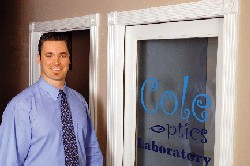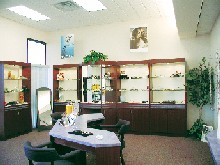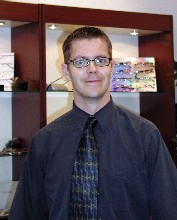With student debt skyrocketing and commercial paychecks beckoning, optometry school graduates are not exactly rushing out to hang a shingle. Yet, even in recent years, a few took the risk and opened their own private practices. Still, theyre quick to point out that it takes much more than just hanging a sign. Strapped with start-up practice debt as well as astronomical student loans, they face all the challenges of running a practice and nurturing its growth.
Some continue to supplement their fledgling practice income with outside jobs. Others devote all their time to building the practice. Either way, all the O.D.s we asked say they are more than willing to make the sacrifices and take the risks in order to practice the way they want.

For someone who is just starting out, 32-year-old Dr. Reeves Cole has big plans: He built a 6,900-square-foot space that houses his first private practice. Photo credit: Robert Osiecki
The steps taken by the O.D.s we spoke to are not much different than those taken by O.D.s who started to practice a generation ago. But, given todays costs and competition, getting through each step was a challenge. Here, some O.D.s share helpful tips for any optometristyoung or experiencedwho wants to open a solo practice.
Get Your Feet Wet
Getting a feel for what its like to work in a real practice setting is priceless. Even if you must endure temporary employment that is not as rewarding as being a practice owner, you will learn a lot that will help prepare you for the lifelong challenges that lie ahead. In fact, not only is work experience helpful; many lenders require it.
One of the lenders I talked to for practice financing required three years of practice experience, says Matthew Hileman, O.D., 29, owner of St. Helena Optometry, St. Helena, Calif.
Use this time to develop your own ideas. And put them down on paper so you are ready to go when you start practicing on your own, Dr. Hileman says.
Whether you begin work in a commercial, institutional or private practice setting, youre sure to learn a thing or two about how you doand dontwant to practice. You also may experience a series of false starts and temporary employment when first getting your feet wet.
While completing a one-year residency in disease and surgical management, Cory Steed, O.D., did fill-in work at several practices. He then went to work for a private O.D., who offered to sell him one of his practice locations.
When I analyzed it, the location didnt seem to have much potential, Dr. Steed says. Maybe thats why the practice owner closed it, putting young Dr. Steed out of a job. He worked for a while at a department store. Not the most enjoyable time of my life, but it paid the bills, he says. He also spent this time looking at other practices for sale.
Develop a Business Plan
The next phase of preparation is writing a business plan, a process that many consider intense. These documents often run about 50 pages and are scrutinized by lenders.
Says 34-year-old Cory Hogan, O.D.: Writing a business plan was more stressful than actually applying for financing. Before opening their Oak Lawn, Ill., practice, Dr. Hogan and her 26-year-old partner, Robert Steinmetz, O.D., labored over all the numbers that they were required to have nailed down.
Although this is a challenging process, the research involved in developing a business plan tells you a lot about the community in which you will practice. For example, before he opened his Lake City, Fla., practice, 32-year-old Reeves Cole, O.D., and his wife considered buying a practice in a neighboring town. It didnt pan out, he says. But the research we did for the business plan gave us valuable information about the demographics and trends in the entire area. As a result, when he opened Lake City Eye Physicians, Dr. Cole was well educated in the opportunities that were available in the town.
Crack the Financing Nut
This is it, the big kahuna that stops young O.D.s in their tracks. According to 2002-2003 figures from the Association of Schools and Colleges of Optometry, O.D.s graduate with an average of $105,074 in debt. As a result, many believe that no lender would entertain a request for another $100,000 (or more) for an unknown and untested optometrist to open a practice.
The good news: This just isnt the case. But that doesnt mean its easy.
When Dr. Steed applied for financing, he had $125,000 in school debt and had recently purchased a house. On paper, he was already in debt for $250,000. Now, he needed to ask for another $200,000.
I didnt think Id get it, he says. But I wrote a business plan, and went to a bank recommended by another O.D. They gave me terms with a six-month grace period of interest only. He also consolidated his student loans to obtain a longer term and lower rate for school debt.
For Dr. Hileman, however, it wasnt as easy. He was initially denied a loan by a credit union that deals solely with optometrists. This surprised him because he was buying a practice that had been in business for 20 years, and thus had a track record.
Im not sure why I was denied; perhaps it was because I didnt have enough experience, says Dr. Hileman, who graduated from University of California at Berkley in 2002 and had been practicing less than two years when he applied for the loan.
He then went to a local bank, which arranged a loan guaranteed by the U.S. Small Business Administration (SBA). The glitch here was that SBA rules required more of a down payment than Dr. Hileman and his wife, Michelle, 27, had. Fortunately, family members helped out with the money they needed, and they got their loan.
Dr. Steed thought about buying an established practice, but instead chose to start fresh in Las Vegas.


This bank was very willing to work with us. I would urge others to start with a local bank, especially if you are in a small town. The denial of our first application set us back six months, Dr. Hileman says.
Drs. Hogan and Steinmetz had the most difficulty with financing, perhaps because they were in the big city, or perhaps because their combined student debt was about $350,000.
No one had a worse situation than we did. We had no financial backing, took no money or loans from family or friends, had no savings, no house, no personal possessionsand a lot of school debt, Dr. Steinmetz says.
First they approached banks that had a reputation for helping small businesses; the banks discouraged them because they didnt have any collateral. Then they turned to a commercial lender that finances health-care practices. They were approved, but not for the full amount ($100,000) they requested. Finally, they turned to a company that primarily finances dental practices.
They gave us the amount we requested at a rate of 7%. Their loan rep was excellent, and answered hundreds of questions from us, Dr. Steinmetz says.
He and Dr. Hogan feel that if they can get financing to start a practice, anyone can: We didnt even know if it was financially feasible, but we were passionately committed to private practice.
Search for a Great Location
Youve heard it said 1,000 times Location, location, location. Says Dr. Steed: We knew we had to find a good one. Dr. Steed and his wife got a map of the city and a Las Vegas phone book and mapped out the locations of all the O.D.s. They found a few pockets where there was no competition, so they considered building an office. Dr. Steed soon concluded that building would take too long, so he decided to lease space. This came with an added benefit: The leasing companies already had research done on traffic patterns and demographics, Dr. Steed says.
He selected a space and had already paid an attorney to review the lease and hired an architect when the lessor changed the terms of the lease. Dr. Steed says he had to give up on this space. Fortunately, he was able to lease 1,400 square feet in a brand new 6,000-square-foot buildingright around the corner.
For Dr. Cole, the location was easier to select. My dad is a real estate developer, he says. Still, the upfront investment turned out to be greater than he expected.
We looked at a lot of sites and found the main area around the mall to be too saturated and expensive, he says. As a result, Dr. Cole settled on some land that his father already owned, near where two main highways connect. His father gave him a great deal on the land, but it required an extensive facelift to transform it into a construction site. After leveling the land by bulldozing, they had to build a retention pond.
Concerned about the time and cost of building from scratch, Dr. Cole went with a modular building, consisting of six factory-built units and a brick exterior installed by a contractor. He says the decision saved them about six months of construction time and cut their building cost dramatically, to about $6,000 per square foot (vs. the typical $9,500 per square foot in that area). Dr. Cole occupies 5,000 square feet of his 6,900-square-foot building, and leases the remaining 1,900 square feet to an engineering firm. That lease pays the monthly mortgage on the building.
Drs. Steinmetz and Hogan took a more straightforward approach. Because they intended to focus heavily on medical optometry, they leased a space in a medical office building occupied by several other health-care practices. They were able to secure the space quickly because of its tiny size (585 square feet), and felt confident they could afford the modest rent ($700 a month). Their location in the south side of Chicago has worked out well.
Its better than we expected, says Dr. Hogan. When we developed the business plan, we didnt expect the patient volume weve achieved. Less than a year after opening Advanced Eyecare Professionals, they have outgrown the small space. Dr. Steinmetz says they will have to find a larger space soon.
Be Ready for Surprises
Each of these O.D. s says there were surprises along the way that they wish they had known to expect:
Construction costs. Everything costs more than you think it will. Build this into your construction or start-up financing.
Construction delays. Any time you deal with contractors, expect delays. Dr. Steed says that, if he were to do it again, he would build financial penalties for delays into the contract.
Advertising costs. This is a substantial expense.
Staff changes. Dr. Hileman purchased a practice with five employees who all supported his purchaseuntil he began making changes. Today, only one of the original five remains.
Insurance challenges. These O.D.s continue to struggle to be included on insurance panels and to be reimbursed for treatment of eye disease.
One thing that did not come as a surprise to these young practice owners is how happy they are with their choice to go into private practice. Although they are making big sacrifices now, they feel strongly that investing in their own practice is an investment in themselves.
Theres so much pride in ownership and building your own financial future. You can be as successful as you want to be, says Dr. Hogan who notes that she is now practicing full-scope optometry. We paid a lot of money to learn how to practice our profession. We should do it.

